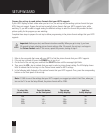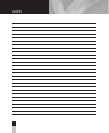
FREQUENTLY
ASKED QUESTIONS
70
WHAT IS HDTV? WHAT ADVANTAGES DOES IT HAVE OVER STANDARD DIGITAL TV ?
HDTV, or high-definition television, is a next-generation standard for digital television that gives you an image
with superior
resolution. Standard televisions display approximately 210,000 pixels, compared to over 2 million
for top-end HDTV – a tenfold increase over traditional TV. Plus, HDTV enhances the home theatre experience by
allowing for wider screens with aspect ratios of 16:9. Among other things, this can preserve a film’s original
letterbox format.
IF I DON’T HAVE AN HDTV, WILL AN HD TERMINAL GIVE ME A SHARPER IMAGE?
No. Vidéotron’s HD terminals are perfectly backward compatible with traditional TV, but to take advantage
of the higher resolution
offered by HD broadcasts, your television must be physically capable of displaying the
necessary number of pixels – and must be equipped with connectors that can carry this type of signal
(Component/DVI/HDMI input).
TECHNICALLY, WHAT’S THE DIFFERENCE BETWEEN HDTV AND TRADITIONAL ANALOG SDTV?
There are several technical differences between standard, NTSC-format television and HDTV. (Technology varies
widely even among HDTVs: CRT, LCD, Plasma, DLP, etc.)
TVs project programs onto their screens in the form of tiny picture elements, or pixels: 480 lines of pixels make
up the picture
on a standard analog TV. In comparison, HDTV images use 720 or 1080 lines, which results in
much sharper detail and general
picture resolution.
This also lets the image be “painted” in different ways. On an SDTV, the screen is painted using interlaced
scanning, meaning
that each of the 30 images appearing on screen each second is made up of two half-images:
one each for the odd and even lines. HDTV can use either interlaced or progressive scanning (the latter changes
the entire image from the first to last line up to 60 times a second).
The two HDTV formats:
720p 720 lines of horizontal resolution and progressive scan
1080i 1080 lines of horizontal resolution and interlaced scan
WHICH IS BETTER, 720P OR 1080I? HOW DO THESE COMPARE WITH DVDS OR THE TRADITIONAL
DIGITAL TERMINAL FORMAT?
Progressive scan provides superior results compared to interlaced scan, the main difference being that interlaced
scan’s alternating lines are more readily visible to the naked eye.
While a 720p image contains fewer pixels than a 1080i image, it also can be refreshed more quickly, making it
the better choice for programs featuring a lot of movement, such as sports broadcasts.
To compare: both SDTV and DVD images use 480 horizontal lines with interlaced scan (480i). So-called progressive
scan DVD players provide images in 480p format, resulting in better picture quality.
FREQUENTLY
ASKED QUESTIONS


















